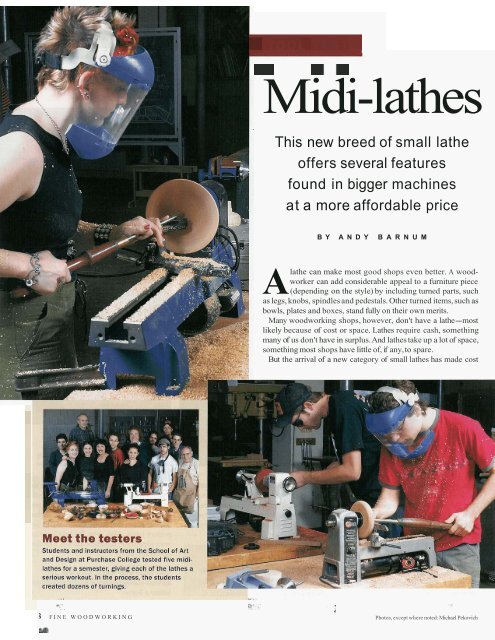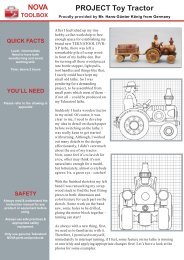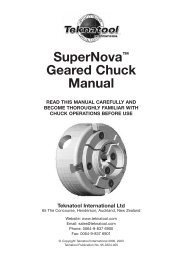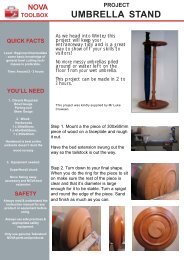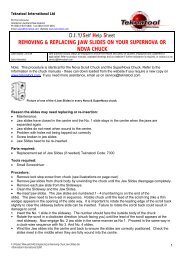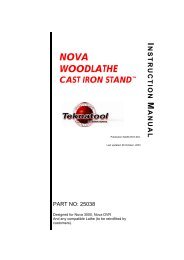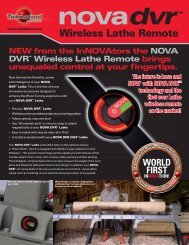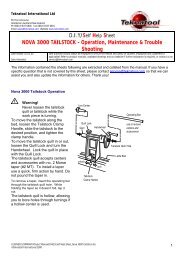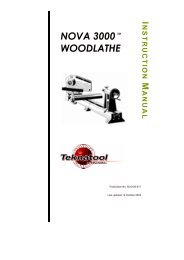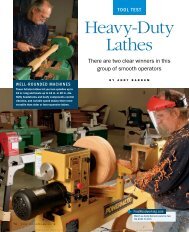You also want an ePaper? Increase the reach of your titles
YUMPU automatically turns print PDFs into web optimized ePapers that Google loves.
-,rnm m<strong>Midi</strong>-<strong>lathes</strong>This new breed of small latheoffers several featuresfound in bigger machinesat a more affordable priceBY ANDY B A R N U MAlathe can make most good shops even better. A woodworkercan add considerable appeal to a furniture piece(depending on the style) by including turned parts, suchas legs, knobs, spindles and pedestals. Other turned items, such asbowls, plates and boxes, stand fully on their own merits.Many woodworking shops, however, don't have a lathe-mostlikely because of cost or space. Lathes require cash, somethingmany of us don't have in surplus. And <strong>lathes</strong> take up a lot of space,something most shops have little of, if any, to spare.But the arrival of a new category of small <strong>lathes</strong> has made coste,'".i. I3 FINE WOODWORKINGm,: .-4'.IPhotos, except where noted: Michael Pekovich
Telephone: (800) 438-2486Street price: $300 ($50 for bedextension)Weight: 65 Ibs.Motor: % hp, 6.6 ampsSwing: 10 in.Distance between centers:14% in. (37 in. with extension)Speed settings (rpm): 500, 800,1,250,1,800, 2,650, 3,700Headstock spindle: I-in. by 8-tpithreads, #2 Morse taperTailstock spindle: #2 Morse taper,1% in. travelFaceplate included: YesOutboard turning option: Noand space less of an issue. Introduced in the late 1990s, these machines-oftencalled midi-<strong>lathes</strong>-are generally bigger and beefierthan the so-called mini<strong>lathes</strong>, yet they're smaller than full-sizedmachines. <strong>Midi</strong>s are affordable-selling for between $285 and$350-and take up very little space. Plus, when not in use, mostcan be picked up and stored out of the way, although a couple ofthe heavier models might best be moved by someone who spendsregular hours at a gym.<strong>Midi</strong>-<strong>lathes</strong> have other features that appeal to me. Unlike mini<strong>lathes</strong>,the midis include some qualities normally found only onbigger machines, such as %-hp motorsand spindles with l-in. by 8-tpithreads and #2 Morse tapers. Also,when used with an optional bed extension,a midi can turn long spindlesbetween centers.For someone unsure whetherwood turning is going to be worthwhile,a midi-lathe just might be thebest way to test the waters. Not onlyare the midis relatively inexpensive,but they also have enough power todo some serious work. And as yourturning skills grow, you can grow thelathe by adding a bed extension.So midi-<strong>lathes</strong> have a lot going forthem. But how well do they work?IStudents give the testI teach wood turning at the School ofArt and Design at Purchase Collegein New York. The shop has 10 fulldsized <strong>lathes</strong>. But the class, part of afurniture:design program, often atc".i ,Photo, this page (top): Tom Begnaltracts as many as 15 students. With an obvious need for more <strong>lathes</strong>,I arranged to borrow the five midi-<strong>lathes</strong> currently on the market-theDelta 46-250, the Fisch TC 90-100, the General 25-100 M1,the Jet JML-1014 and the Nova Mercury-to find out how well theycould hold up to the wear and tear of regular use. By the way, theNova Mercury is marketed as a minilathe, even though it has aM-hp motor, 1-in. spindles, #2 Morse tapers and an expandablebed, all features found on the other midis. So I felt comfortable includingit in the midi-lathe group.To find out how the midis would hold up under daily use, eachany speed change on the Delta, Fisch,General or Jet, the belt (left) is repositionedon stepped pulleys. Changingspeeds on the Nova (right) is mostly justa matter of turning a dial.SEPTEMBERLOCTOBER 2002 69%
At 81 Ibs., the Fisch weighs slightly more than the average midi-latheweight of 74 Ibs. It has the lowest price of the bunch. And, at 15 in., itties for the most distance between centers without a bed extension. Theon/off switch is conveniently located in the headstock.one was put to work in my once-a-week, all-day class for an entiresemester. As the semester progressed, the student testers providedplenty of candid feedback on the strengths and weaknesses ofeach, machine. Here’s what we found.Power isn’t a problemAnyone taking a quick look at these small <strong>lathes</strong> might be temptedto dismiss them as less-than-serious machines. So right off thebat we wanted to know if they have enough power. And within a- few weeks, after turning an assortment of bowls, plates and spin-’ dles, the students concluded that they do. The %-hp motors, a sizethat’s often standard on larger (12-in.) <strong>lathes</strong>, provided all the musclewe needed.Dial-a-speed is simplerLathes are designed to run at severalspeeds to accommodate different sizedworkpieces. Large, heavy workpiecesrequire a slow speed, while small, lightparts can be spun considerably faster.So it’s helpful to be able to changespeeds without a lot of annoyance.IThe Nova stands out from the othersin this regard. Thanks to a d.c. motor, athree-step pulley and variable-speedcontrol, the Nova has an overall speedrange of 140 rpm to 5,350 rpm. Dependingon the pulley location, thelathe can be set to slow (140 rpm to1,750 rpmj, medium (320 rpm to 3,670rpm) or fast (470 rpm to 5,350 rpm).The medium speed range took care ofalmost all of our needs. And becauseL . ,1 ,,.r:”4. I70 FINE WOODWORKINGthe belt setting was rarely changed, speeds were varied simply byturning a dial.The Delta, Fisch, General and Jet have six speeds each (see thecharts for more specs). To change speeds, the motor must first beraised and then a V-belt shifted to the appropriate position on astep pulley. While the procedure isn’t a major headache, it fallsshort of the simpler Nova system. Also, the small belts on all ofthese <strong>lathes</strong> made belt tensioning a bit fussy. If it’s too loose, thebelt could slip; if it’s too tight, the belt could strain the bearings.Cast-iron parts make a beefier machineA lathe should feel solid and steady during the turning process. Excessivevibration or movement can interfere with tool control and,A plywood baseadds support, Tomake sure thesemachines don’tmove around whilein use, it’s a goodidea to bolt the feetto a piece of plywood,then clampthe plywood to thebench. The onlylathe not eager towander was the General.Its large. - . softrubberkeep itfeet helpedin place.Photos, this page (top) and facing page (bottom): Tom Begnal?p
~ fromFaceplates welcomed. A steel faceplate is supplied as a standarditem on all of the midi-<strong>lathes</strong> reviewed.ultimately, the quality of the wood surface. While the midi-<strong>lathes</strong>aren't as rock-solid as most full-sized <strong>lathes</strong>, they are hardly rickety,mainly because the beds, headstocks'and tailstocks are madecast iron, a material favored for its vibration-dampeningproperty. Also, on each of the <strong>lathes</strong> we looked at, the way on thebed-which allows both the tailstock and tool rest to slide-wasground smoothly.We did notice, though,. that because midis are relatively light inweight, all but the General moved around on the benchtop a bitwhen in use. Four large, soft rubber feet kept the General lathefrom wandering. To keep the others solidly in place, it's a goodidea to bolt them to a plywood base and then clamp the plywoodto a sturdy workbench.Headstocks have sturdy spindlesThe 1-in. headstock spindle really separates these <strong>lathes</strong> from theprevious generation of mini<strong>lathes</strong>. Those earlier <strong>lathes</strong> used %-in.-dia. spindles, making them more likely to flex and vibrate.Each of the five <strong>lathes</strong> has a headstock spindle with 1-in. by 8-tpithreads and a #2 Morse taper. And all accept a faceplate. The Novaallows outboard turningwhen used with an optionaloutrigger unit.Two <strong>lathes</strong>, the Delta andthe Jet, come with a handwheelat the outboard end ofthe spindle. This useful featuremakes it easy to checktool-rest clearance and to examinework in progress.Tailstocksoffer live centersExcept for the Nova, all of themidi-<strong>lathes</strong> have a tailstockspindle with a live cup centerand a #2 Morse taper. TheNova uses a live single-pointcenter along with the #2-II__. -~.... Better and best. Onry Lrle Nova usesa live single-point center (right) inthe tailstock; the other midis use alive cup center (left). The students... ...CC._Iravo#=U L I ~ G ~lvc-bup VG~JIWII.Morse taper.All proved to be an improvement over the dead cup center ofold, but for most work we preferred a live cup center over a livesingle-point center because the live cup center engages the woodBy far, the General is the heaviest of the midis, weighing in at106 Ibs. At 15 in., it ties the Fisch for the most distance betweencenters, sans a bed extension. Add the long bed extension, and itprovides 45 in. between centers, more than any of the othermidis reviewed.!3SEPTEMBERIOCTOBER 2002 71
This midi weighs in at just 59 Ibs., a number that back muscles willappreciate. With the bed extension added, the Jet has 40 in. betweencenters, one of the longest. At a price of $350, it is the most expensillathe in this group.more solidly. A live single-point center can wear away at the woodand eventually loosen.The tailstock on each of these <strong>lathes</strong> uses either a cam lock or aquick lock, providing the convenience of one-handed moving andlocking. To lock the tailstock in place you simply give the handlea quarter turn. These locks worked just fine and proved to be anice plus.On the Delta, Fisch and Jet, a handwheel is turned to adjust thetailstock spindle in or out. The Nova incorporates a knurled knobthat made the task less convenient.The Delta, Fisch, General and Jet have self-ejecting systems forthe Morse taper center, a feature we liked because it was quick andeasy to use and didn’t require an extra tool. You simply retract thespindle, and the center pops loose. The Nova gets the job donewith a long, cylindrical piece of steel called aknockout bar. You slip the bar into the hollowspindle, then the bar is used to tap the Morse taperand free it up.Short tool restslack support. A6-in.-long toolrest, the standardfor all of the machines,wasn’t favoredby the students.Longertool rests areavailable aftermarket...I,,,.*?r..A longer tool rest would be a nice upgradeAll of these midi-<strong>lathes</strong> have relatively short (6-in.)tool rests, which drew many complaints from thestudents. They wanted a longer tool rest thatwouldn’t have to be repositioned as frequentlywhen turning a long piece.A longer tool rest (12 in.) is available from Fischas an option. We tried it, and it quickly proved tobe a hit. It also worked on all of the other midis,but to fit the Nova we had to sand down the shaftdiameter a bit. By the way, Fisch also offers an optionalcurved bowl-turning rest.The best full-sized <strong>lathes</strong> feature a cam lock tosecure the base of the tool rest. A cam lock allowsfor easy one-handed adjustments of the tool rest.The midis all had a sturdy scaled-down version ofthe cam lock that worked just fine.Choosing a favorite was a challengeBy the end of the semester, all five of these midi<strong>lathes</strong>had accumulated a good many hours of run72 FINE WOODWORKING Photos, this page (top) and facing page (top): Tom Begnalyp
*.IAlthough it’s the lightest and most compact of all the midis, the Nova islimited to 8 in. between centers without a bed extension, 20 in. withone. Variable-speed control makes it quick and easy to change speed S.It’s the only one that allows outboard turning.-time. Yet all of them were still going strong. And along the way, thestudents were able to create dozens of remarkable turnings.That said, when forced to pick a favorite, we ended up giving aslight nod to the Nova. It’s the lightest and most compact of thebunch, so it’s easier to carry and store. Those are important featuresin our shop.Also, on the Nova, we like the simplicity of the variable-speeddial. It pretty much eliminates the need to fuss with belts whenchanging speeds. That’s a nice plus.On the downside, though, the Nova has the shortest distance betweencenters. Adding the bed extension increases the distancebetween centers, but when compared to others with added bedextensions, the Nova still comes up short in the length department.Everything considered, though, we were more than pleased withthe performance of all these <strong>lathes</strong>. Indeed, the machines dideverything we asked of them from the first day of class to the last.Anyone looking to get started in wood turning, but with a limitedbudget or minimal shop space, ought to consider taking a closerlook at these little <strong>lathes</strong>.In addition to teaching wood turning at Purchase College and BrookfieldCraft Center, Andy Barnurn builds furniture at his shop in Carmel, N.Y.- .I’, SEPTEMBER/OCTOBER 2002 73


